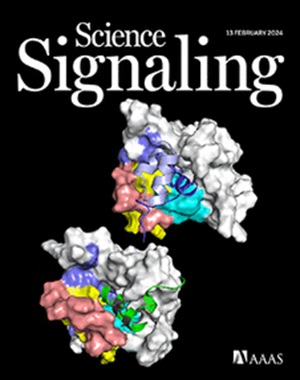细菌丝氨酸-苏氨酸激酶图谱揭示了与真核生物激酶的功能多样性和关键区别
IF 6.6
1区 生物学
Q1 BIOCHEMISTRY & MOLECULAR BIOLOGY
引用次数: 0
摘要
细菌丝氨酸-苏氨酸激酶(STKs)调节与细胞生长、毒力和致病性相关的多种细胞过程,并与可用药的真核STKs进化相关。深入了解细菌STKs与真核细胞的不同之处,以及它们如何进化以调节各种细菌信号功能,对于推进新抗生素疗法的发现和开发至关重要。在这里,我们根据保守催化结构域和侧翼调控结构域的进化约束模式,将NCBI RefSeq非冗余和UniProt蛋白数据库中的30多万个细菌STK序列分类为35个典型和7个伪激酶家族。通过统计比较,我们确定了区分细菌STKs与真核STKs的特征,包括调节螺旋(C螺旋)中的精氨酸残基,该螺旋动态偶联激酶结构域的ATP和底物结合叶。生化和肽库筛选表明,进化受限的残基有助于结核分枝杆菌激酶PknB的底物特异性和激酶激活。总之,这些发现为研究细菌STK在细胞信号传导中的功能和开发选择性细菌STK抑制剂开辟了以前未知的途径。本文章由计算机程序翻译,如有差异,请以英文原文为准。
An atlas of bacterial serine-threonine kinases reveals functional diversity and key distinctions from eukaryotic kinases
Bacterial serine-threonine kinases (STKs) regulate diverse cellular processes associated with cell growth, virulence, and pathogenicity and are evolutionarily related to the druggable eukaryotic STKs. A deeper understanding of how bacterial STKs differ from their eukaryotic counterparts and how they have evolved to regulate diverse bacterial signaling functions is crucial for advancing the discovery and development of new antibiotic therapies. Here, we classified more than 300,000 bacterial STK sequences from the NCBI RefSeq nonredundant and UniProt protein databases into 35 canonical and seven pseudokinase families on the basis of the patterns of evolutionary constraints in the conserved catalytic domain and flanking regulatory domains. Through statistical comparisons, we identified features distinguishing bacterial STKs from eukaryotic STKs, including an arginine residue in a regulatory helix (C helix) that dynamically couples the ATP- and substrate-binding lobes of the kinase domain. Biochemical and peptide library screens demonstrated that evolutionarily constrained residues contributed to substrate specificity and kinase activation in the Mycobacterium tuberculosis kinase PknB. Together, these findings open previously unidentified avenues for investigating bacterial STK functions in cellular signaling and for developing selective bacterial STK inhibitors.
求助全文
通过发布文献求助,成功后即可免费获取论文全文。
去求助
来源期刊

Science Signaling
BIOCHEMISTRY & MOLECULAR BIOLOGY-CELL BIOLOGY
CiteScore
9.50
自引率
0.00%
发文量
148
审稿时长
3-8 weeks
期刊介绍:
"Science Signaling" is a reputable, peer-reviewed journal dedicated to the exploration of cell communication mechanisms, offering a comprehensive view of the intricate processes that govern cellular regulation. This journal, published weekly online by the American Association for the Advancement of Science (AAAS), is a go-to resource for the latest research in cell signaling and its various facets.
The journal's scope encompasses a broad range of topics, including the study of signaling networks, synthetic biology, systems biology, and the application of these findings in drug discovery. It also delves into the computational and modeling aspects of regulatory pathways, providing insights into how cells communicate and respond to their environment.
In addition to publishing full-length articles that report on groundbreaking research, "Science Signaling" also features reviews that synthesize current knowledge in the field, focus articles that highlight specific areas of interest, and editor-written highlights that draw attention to particularly significant studies. This mix of content ensures that the journal serves as a valuable resource for both researchers and professionals looking to stay abreast of the latest advancements in cell communication science.
 求助内容:
求助内容: 应助结果提醒方式:
应助结果提醒方式:


